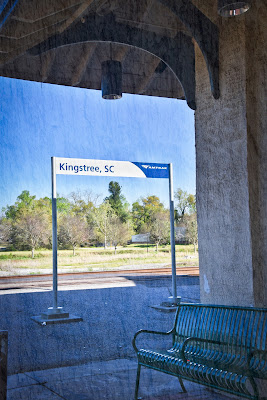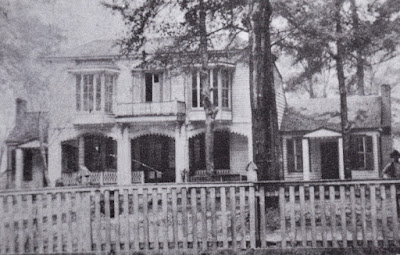Bessie Britton began a newspaper column published in The County Record in January 1952 with these words: The first brick store in Kingstree was Reddick's Red Hot Racket Emporium at 110 West Main Street. She then broke down the name to explain that "red hot" meant goods priced to sell; "racket" meant departments; and "emporium" meant dry goods of every kind in stock.
Reddick's store in an undated photo from the Williamsburgh Historical Museum.
That name certainly has a ring to it, but I suspect Miss Bessie may have gilded the lily a wee bit. In newspaper articles and advertisements, the store was called Reddick's Broadway Racket Store, or Reddick's Racket Store, or just H.D. Reddick's.
Henry D. Reddick went into business in Kingstree, along with his brother, William J. Reddick, sometime in the 1890s. The store was originally three stores that he acquired over a period of years. In 1899, he remodeled them into one big, for the time, brick store. George S. Barr, as Kingstree correspondent for The State newspaper, noted that when completed, it would be "one of the finest stores in the county."
In a June 1898 profile of Kingstree in the Charleston Evening Post, Reddick's was described like this. "In any town there are merchants who lead and never follow. Such is the case in Kingstree with the enterprising concern known as the Broadway Racket Store, of which Mr. H.D. Reddick is the proprietor. Mr. Reddick deserves a great deal of praise, starting as he did with a capital of only $300, and viewing now his large commodious establishment."
Reddick's, like many other merchants in Kingstree, always operated on the proverbial shoestring. In 1901 and again in 1910, he declared voluntary bankruptcy. Both times, he was able to satisfy his creditors and re-open. In 1901, he re-opened in the middle of December, only to have vandals break his quarter-inch-thick plate glass window two weeks later.
The 1907 "Going Out of Business" ad run for Reddick's by the Mutual Clearance Co.
Henry Reddick appears to have been a restless soul. In 1907, he decided to move away from Kingstree, and went so far as to turn all of his worldly goods over to the Mutual Clearance Company for a huge "Going Out of Business" sale. Whether or not his decision to move had anything to do with his wife's illness is unknown, but Isadora Reddick died in October of that year after what was described as a "lingering illness." And, after her death, Henry Reddick remained in Kingstree.
In 1908, he installed a new awning on his store which The County Record said added to the storefront's appearance and "is also an interesting proposition from a mechanical standpoint." If you look closely at the photo above, you can see that the awning is rolled back, and there appears to be a system of ropes to unfurl it when needed. In 1909, he rented a store on the opposite side of Main Street as a coffin repository for the undertaking business he ran out of the Racket Store. He also spoke of plans to add two additional floors to the storefront, which would have made it the largest store in town. He apparently thought better of that idea as the additional floors never happened. He also remarried in 1909.
Meanwhile, he opened branches of his store in Denmark, Bamberg, Lake City, and Hartsville. None of these stores appears to have stayed open very long.
After his 1910 bankruptcy, W.I. Nexsen bought the store, remodeling it in 1913. Reddick continued to operate out of the building after it was remodeled. However, in the early morning hours of April 2, 1915, the town's night watchman, Harry Bradley, discovered a fire in the store. It was obviously an attempt at arson as there was evidence that kerosene had been poured around the desk where the fire started. Thanks to Bradley's early discovery and quick action by the Kingstree Fire Department, very little damage occurred. However, The County Record announced in mid- April. "Mr. H.D. Reddick will leave Kingstree as soon as his losses sustained by the fire of April 2 can be adjusted and will make his future home in Andrews where he has opened a store known as the Andrews Dry Goods Company, now under the management of his son, Mr. Cordie Reddick. Mr. Reddick is one of the pioneer merchants of Kingstree, and we view with regret his approaching departure."
Advertisement for Lewis & Carter's grand opening in 1915.
By July 1, 1915, a new grocery store, Lewis & Carter, had opened in the building. Although no first names were given, they were described as both being "popular young Kingstree boys."
Henry Reddick continued to visit regularly in Kingstree after his move to Andrews, as his brother, Billy, still lived here. But he didn't stay in Andrews long. By 1916, he had moved to Easley. He remained in the upstate the rest of his life, dying in Greenville at age 70 in 1933.
But the memory of Reddick's store lived on. For the March 31, 1954, issue of The Florence Morning News, Ann McIntosh wrote a human interest story on Arthur Dukes' hat. The story began: "Uncle Arthur Dukes took the black hat from his head and turned it fondly in his gnarled hands. He has worn it for 40 years, so long that his white friends cannot ever remember seeing him without it..."
The hat was a John B. Stetson he said he bought from Mr. Henry and Mr. Billy Reddick for $1.50 back before the first World War. He had taken good care of the hat and it continued to serve him well. He was 87 years old in 1954 and had clear memories of the 1886 earthquake. He also remembered that W.I. Nexsen's Hudson was the first automobile he had ever seen.
Reddick's old store today is the home of the Sabb Law Group.
Today, while Reddick's Broadway Racket Store is not a landmark most of us would recognize, the building in which it operated still stands on the north side of West Main Street. It is now owned by State Senator Ronnie A. Sabb and is home to his law practice.


































